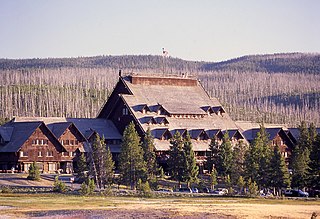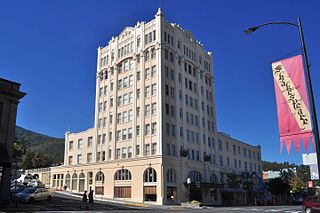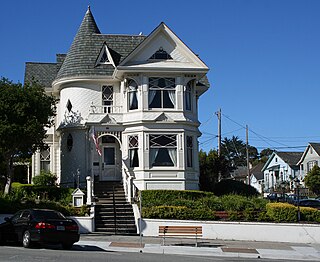
The Old Faithful Inn is a hotel in the western United States with a view of the Old Faithful Geyser, located in Yellowstone National Park, Wyoming. The Inn has a multi-story log lobby, flanked by long frame wings containing guest rooms. In the western portion of the park, it sits at an approximate elevation of 7,350 feet (2,240 m) above sea level.

Horace Trumbauer was a prominent American architect of the Gilded Age, known for designing residential manors for the wealthy. Later in his career he also designed hotels, office buildings, and much of the campus of Duke University. Trumbauer's massive palaces flattered the egos of his "robber baron" clients, but were dismissed by his professional peers. His work made him a wealthy man, but his buildings rarely received positive critical recognition. Today, however, he is hailed as one of America's premier architects, with his buildings drawing critical acclaim even to this day.

G. W. & W. D. Hewitt was a prominent architectural firm in the eastern United States at the turn of the twentieth century. It was founded in Philadelphia in 1878, by brothers George Wattson Hewitt (1841–1916) and William Dempster Hewitt (1847–1924), both members of the American Institute of Architects. The firm specialized in churches, hotels and palatial residences, especially crenelated mansions such as Maybrook (1881), Druim Moir (1885–86) and Boldt Castle (1900–04). The last was built for George C. Boldt, owner of Philadelphia's Bellevue-Stratford Hotel (1902–04), G.W. & W.D. Hewitt's most well-known building.

The Omni Grove Park is a historical resort hotel on the western-facing slope of Sunset Mountain within the Blue Ridge Mountains, in Asheville, North Carolina. It has been visited by various presidents of the United States and many other notable personages. Listed on the National Register of Historic Places, the hotel is an example of the Arts and Crafts style. It also features a £38 Million, 3,700-square-metre (40,000 sq ft), modern subterranean spa. The Grove Park Inn is a member of the Historic Hotel of America, the program of the National Trust for Historic Preservation. The Grove Park Inn also owns an 18-hole golf course situated on the hill below the hotel. Donald Ross designed the original course.

Western State Hospital, called Western State Lunatic Asylum in its early years, is a hospital for the mentally ill in Staunton, Virginia, which admitted its first patient on July 24, 1828.

The Dearborn Inn, A Marriott Hotel, is a luxurious historic hotel, conceived by Henry Ford, who saw a need for food and accommodations for visitors flying into the nearby Ford Airport, making it one of the first airport hotels. It is located in Metro Detroit at 20301 Oakwood Boulevard in the suburban city of Dearborn, Michigan near The Henry Ford and the world headquarters building of Ford Motor Company. Albert Kahn designed the Dearborn Inn in the Georgian architectural style. The Dearborn Inn is owned by Ford Motor Land Development Corporation and managed by Marriott International.

The historic 21-story Rhodes–Haverty Building was, at the time of its construction in 1929, the tallest building in Atlanta, Georgia. Designed by Atlanta architects Pringle and Smith, the building was built by furniture magnates A. G. Rhodes of Rhodes Furniture and J. J. Haverty of Havertys. It remained the tallest building in Atlanta until 1954.
Charles Emmett Cassell was a Baltimore, Maryland-based architect.

The Hotel Yancey in Grand Island, Nebraska, also known as The Yancey Motor Inn, is an eleven-story building built during 1917-1923 that remained, in 1982, the tallest building in the city. Its design reflects Renaissance Revival architecture.

The Ashland Springs Hotel is a historic hotel in Ashland, Oregon, United States. Built in 1925, it was formerly known as the Mark Antony Motor Hotel or the Lithia Springs Hotel. It was listed on the National Register of Historic Places in 1978. The hotel is also a member of Historic Hotels of America, the official program of the National Trust for Historic Preservation.
In the United States, the National Register of Historic Places classifies its listings by various types of architecture. Listed properties often are given one or more of 40 standard architectural style classifications that appear in the National Register Information System (NRIS) database. Other properties are given a custom architectural description with "vernacular" or other qualifiers, and others have no style classification. Many National Register-listed properties do not fit into the several categories listed here, or they fit into more specialized subcategories.

Beagle Hotel was a historic inn and tavern located near Valley Grove, Ohio County, West Virginia. It was built before 1827 and operated as the Beagle Hotel until 1893. Attached to the hotel was a general store. Both buildings were 2 1/2 stories high and covered in clapboard.

The Lane Hotel, also known as the Hotel Mathews and The White Dog Inn, is a historic inn and tavern located at Mathews, Mathews County, Virginia. It was built about 1840, and is a 2 1/2-story, rectangular frame building with an adjoining kitchen. It features a prominent two-story Greek Revival front porch added in 1916 and a three-part, semi-circular window under the front gable known as a "Billups" Window. Also added in 1916 to the east and west of the original building are two-story square wings. The building was moved back from Grove street an approximate distance of 25 feet in 1916.

Hotel Indigo Atlanta Midtown is a historic building in midtown Atlanta, Georgia. Designed by Atlanta-based architectural firm Pringle and Smith in 1925, the brick building is located on Peachtree Street, across from the Fox Theatre.

Williamsburg Inn is a historic large resort hotel located at Williamsburg, Virginia. It was built in three phases between 1937 and 1972. The original section was designed by Perry Dean Rogers Architects and is dominated by a two-story portico which stands atop a ground floor arcade. It is a three-story, seven-bay, Colonial Revival style brick structure. It has two-story flanking wings in an "H"-shape. The East Wing addition, also by Perry Dean Rogers Architects, consists of multiple wings of guest rooms set at right angles to one another. A third phase embracing the Regency Dining Room and its adjoining courtyard, was completed in 1972. The Williamsburg Inn is one of the nation's finest resort hotels, internationally acclaimed for its accommodations, service and cuisine. It represented John D. Rockefeller, Jr.'s commitment to bring the message of Williamsburg to a larger audience of influential Americans.

Historic Hotels of America is a program of the National Trust for Historic Preservation that was founded in 1989 with 32 charter members; the program accepts nominations and identifies hotels that have maintained their authenticity, sense of place, and architectural integrity. In 2015, the program included over 260 members in 44 states, including the District of Columbia, Puerto Rico, and the U.S. Virgin Islands. In 2022, the program includes 273 hotels.

The Colony Hotel & Cabaña Club, in Delray Beach, Florida, is a Spanish Colonial Revival-style hotel dating from 1926, plus a separate beach-side recreation area with pool and cabañas. The hotel features Florida Mediterranean architecture in a three-story building with two domed towers. It has been described as "the best known landmark" in Delray Beach.
The Morris Inn at Notre Dame is a Gothic Revival-style hotel owned by the University of Notre Dame and located on the school's campus in Notre Dame, Indiana.

The Gosby House Inn, in Pacific Grove, California, is a two-story Victorian mansion that was built in 1887 by J.F. Gosby. The Inn evolved architecturally in stages, from a vernacular boarding house serving a religious retreat to a Queen Anne hotel catering to vacationers. The Victorian was listed on the National Register of Historic Places on December 2, 1980. In 2022 it is still operating as a bed and breakfast lodging establishment.
















